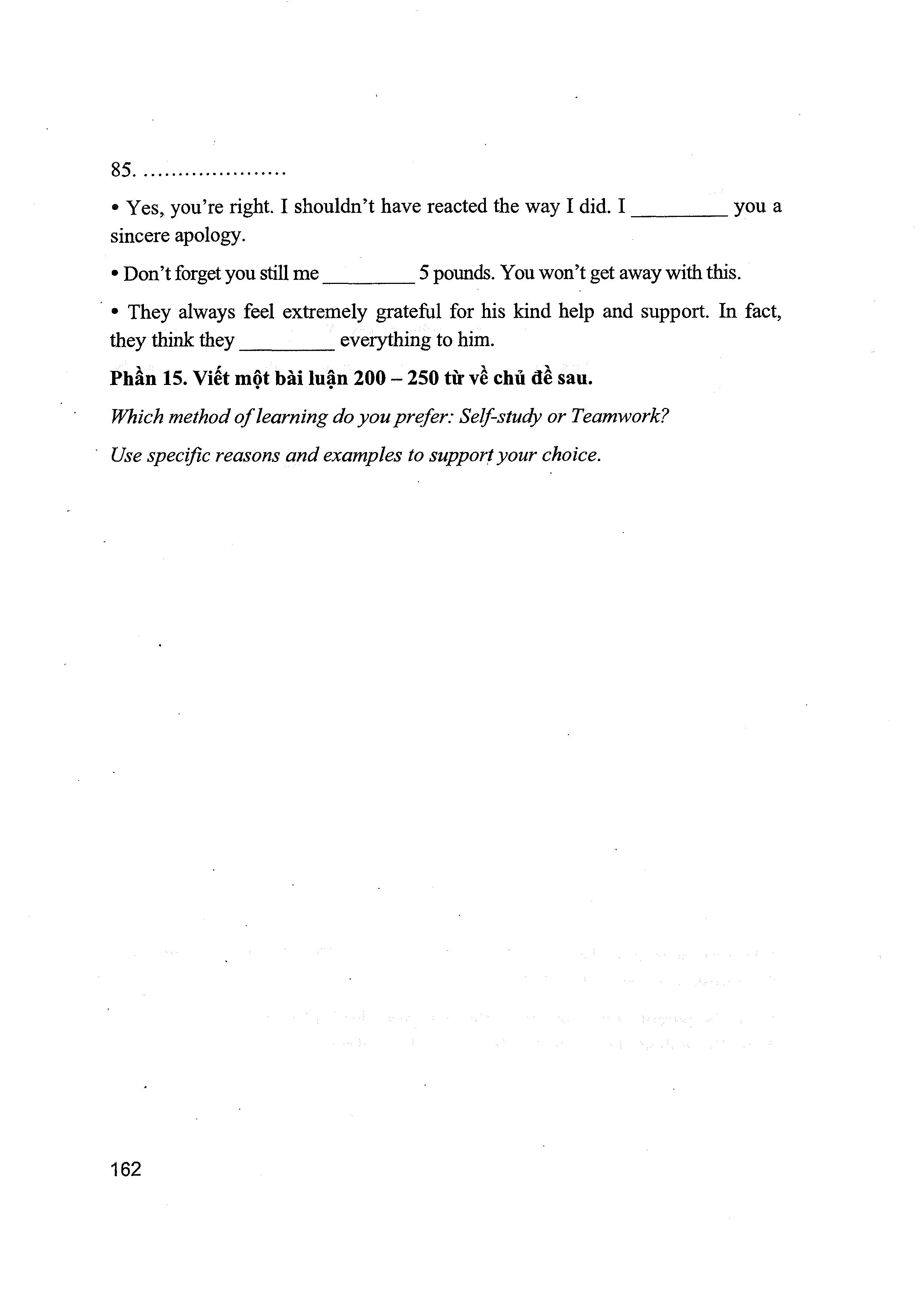
21 minute read
Progress test 8
from 20 ĐỀ LUYỆN TẬP THI VÀO 10 CHUYÊN NGOẠI NGỮ - ĐÁNH GIÁ NĂNG LỰC NGOẠI NGỮ TIẾNG ANH - GỢI Ý BÀI LÀM
PROGRESS TEST 8
Phần 1. Cách phát âm của âm yị trong từ Chọn 01 trong 04 lựa chọn có phần gạch chân có cách phát âm khác vói những từ còn lại.
Advertisement
1. A. treachery B. treasure c. feature 2. A. cleanse B. clean c. mean 3. A. fragile B. bargain c. general 4. A. owl B. howl c. bowl D. meadow D. glean D. luggage D. fowl
5. A. exam B. exaggerate c. exist D. maximum
Phần 2. Trọng âm Chọn 01 trong 04 lựa chọn có cấu trúc trọng âm khác vói những từ còn lại.
6. A. newspaper B. multiply
7. A. pronounce
B. money 8. A. entertainment B. documentary 9. A. education B. demonstration c. magical c. answer c. appropriate c. opposition D. allowance D. lesson D. information D. activity
10. A. terminal B. consensus c. digital D. camera
Phan 3. Từ hoặc cụm từ đồng nghĩa Chọn 01 từ/cụm từ trong 04 lựa chọn có nghĩa gần nhất với từ/cụm từ được gạch chân.
11. Although he is recognized as one o f the most brilliant scientists in his field, Professor White cannot seem to make his ideas understood in class. A. get his ideas down c. summarize his ideas B. recall his ideas D. get his ideas across 12. The introduction o f credit cards radically modified North Americans' spending habits. A. devoted B. altered C. reduced D. resolved
148
13. We had waited for two hours and in the end they arrived. A. luckily B. suddenly c. gradually D. eventually
Phần 4. Từ hoặc cụm từ trái nghĩa
Chọn 01 từ/cụm từ trong 04 lựa chọn trái nghĩa vói từ/cụm từ được gạch chân.
14. Why are you being so arrogant? That you can do it doesn’t mean you are the best. A. humble B. cunning c. pig-headed D. big-heated 15. The soldiers were told to commence firing in the mock battle. A. continue B. stop c. begin D. evoke 16. The consequences of the typhoon were disastrous due to the lack of precautionary measures.
A. severe B. beneficial c . physical D. damaging
Phần 5. Tìm lỗi sai
Chọn 01 trong 04 từ/cụm từ được gạch chân có chứa lỗi sai.
17. Alike (A) other forms o f energy, natural gas may be used (BÌ to heat fCi homes, cook food, and even run ('Di automobiles. 18. He was the son o f a French immigration (A), who ('Bi later began calling himself (CÌ Revere to make his name easier (D) for Americans to pronounce. 19. In order to (A) get married in this state, one must present (BÌ a medical report along with (C) your (D) identification. 20. First raise (A) vour right hand, and then (BX you should (C) repeat after me (Dil l . From the airplane (A), passengers are able (B) to clearly see (C) the outline o f (D) the whole island. 22. Living (A) in New York, apartments cost more (B) to rent than (C) they do in other, smaller (D) cities.

149
Phần 6. Hoàn thành câu
Chọn 01 lựa chọn đúng trong 04 lựa chọn cho sẵn để điền vào chỗ trống trong mỗi câu hỏi.
2 3 .1 remember _________ the letter a few days before going in holiday. A. to receive B. to have received c . received D. receiving 24. There was n o _________ in continuing for him the race was over. A. value B. worth c . point D. profit 25. She had to pass all her exams o r_________ she would have no holiday. A. instead B. else c. therefore D. though 26. The headteacher again brought _________ the issue o f reintroducing school uniforms. A. back B. down c . up D. in 27 . _________the time you reach the station, the train will have left. A. A t B. On c . By D. In 2 8 .1 object_________ the proposal to restrict the use o f cars in the city. A. at B. with c. for D. to 2 9 .1 can’t tell Peter and Pall apart: They a re_________ twins. A. similar B. alike c . resemblance D. identical

30. People believe there is a _________ between the two crimes.
A. join B. chain
c . link D. connector 31. If you can’t find what you want in this chapter, look it up in the
A. reference B. index c. catalogue D. directory 32. You c a n _________ me the details. I don’t want to know all about your argument with your boss. A. spare B. save c. deprive D. avoid
150
Phần 7. Điền từ
Chọn 01 lựa chọn đúng trong 04 lựa chọn cho sẵn để điền vào chỗ trống trong đoạn v ă n ..
RENOIR THE FILM DIRECTOR
Film directors usually make the least promising subjects for biography. They tend to stay behind the camera and get on with making films, emerging only to make the (3 3 )_________promotional statement. Only rarely is a filmmaker interesting enough to merit biographical interest, and some pay o ff the attention handsomely. What biographer could (34) _________ analyzing Hitchcock, Woody Allen or Polanski? These directors, in any case, were themselves sufficiently absorbed in their own image to cross over the other side o f the camera and (3 5 )_________themselves to the public. Much of Jean Renoir’s public profile is based on his appearance in his final film. But judging by the most recent biography, by Ronald Bergar, the man was simply not that interesting. He grew up in the benevolent (36) _________of his painter father, against whom he appears not to have rebelled in any way, emerged to make his own ( 3 7 )_________ in the early French cinema, and went on making films for most o f the rest o f his life. Even when faced by war, Renoir seems to have (3 8 )_________through his career with equanimity, fuelled by the love of all around him. It may be that there is nothing new to say about the director's life, since he dealt with it so thoroughly in two ( 3 9 )_________. Bergar takes a lot from Renoir’s accounts, although he does point out the occasional discrepancy between memory and fact. The biography is too respectful to strike any life into the subject. Bergar's assessments of the films are level-headed and pay (40) attention to their formal achievement, but cast no new life on them.
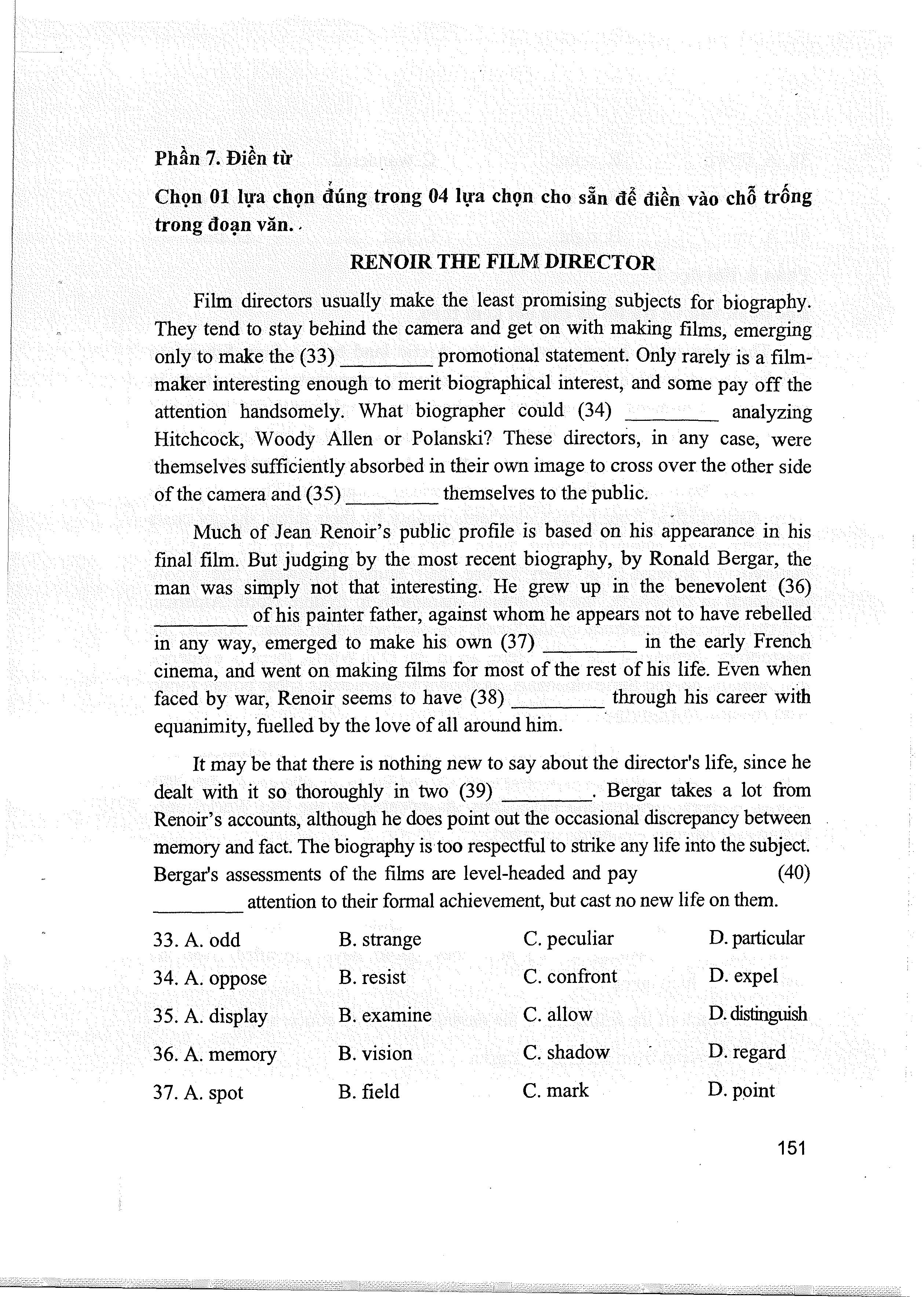
33. A. odd 34. A. oppose 35. A. display 36. A. memory 37. A. spot B. strange B. resist B. examine B. vision B. field c. peculiar c. confront c. allow c. shadow c. mark D. particular D. expel D. distinguish D. regard D. point
151
38. A. flown B. sailed c. wandered D. run 39. A. souvenirs B. memoirs c. reminiscences D. revivals 40. A. due B. right P h ần 8. B ài đọc 1 Đọc đoạn văn và tr ả lòi 08 câu hỏi kèm theo. The time when humans crossed the Arctic land bridge from Siberia to Alaska seems remote to us today, but actually represents a late stage in prehistory of humans, an era when polished stone implements and bows and arrows were already being used and dogs had already been domesticated. When these early m igrants arrived in North America, they found the woods and plains dominated by three types of American mammoths. Those elephants were distinguished from today's elephants mainly by their thick, shaggy coats and their huge, upward-curving tusks. They had arrived on the continent hundreds of thousands of years before their human followers. The wooly mammoth in the North, the Columbian mammoth in middle North America, and the imperial mammoth o f the South, together with their distant cousins the mastodons, dominated the land. Here, as in the Old World, there is evidence that humans hunted these elephants, as shown by numerous spear points found with mammoth rem ain s. Then, at the end o f the Ice Age, when the last glaciers had retreated, there was a relatively sudden and widespread extinction o f elephants, in the New World, both mammoths and mastodons disappeared, in the Old World, only Indian and African elephants survived. Why did the huge, seemingly successful mammoths disappear? Were humans connected with their extinction? Perhaps, but at that time, although they were cunning hunters, humans were still widely scattered and not very numerous. It is difficult to see how they could have prevailed over the mammoth to such an extent. 41. With which o f the following is the passage primarily concerned? A. Migration from Siberia to Alaska B. Techniques used to hunt mammoths c. just D. fine
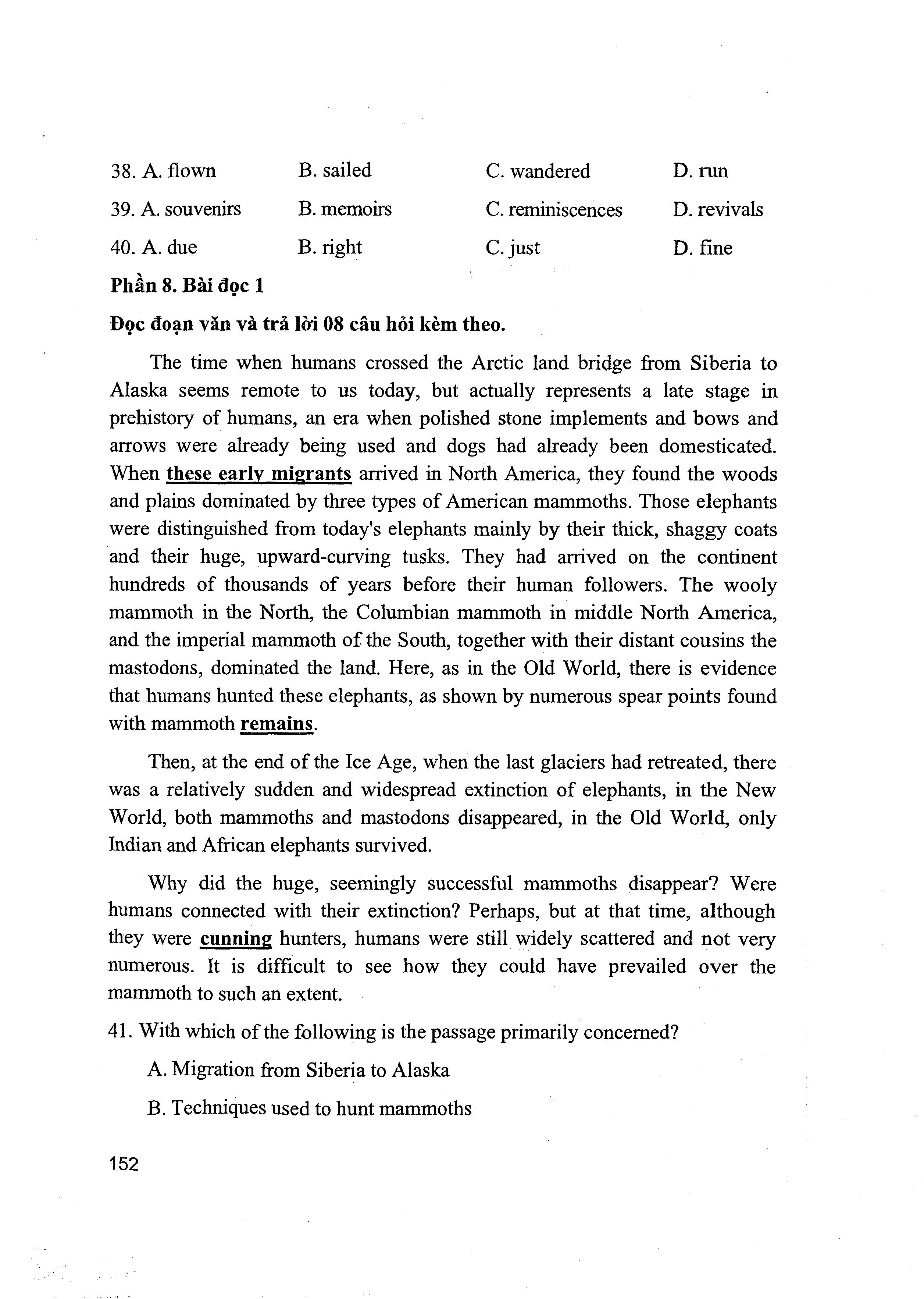
152
C. The prehistory of humans D. The relationship between man and mammoth in the New World 42. The phrase "these early migrants" refers t o _________ . A. mammoths B. humans C. dogs D. mastodons 43. Where were the imperial mammoths the dominant type of mammoth? A. Alaska B. the central portion o f North America C. the southern part o f North America D. South America 44. It can be inferred that when humans crossed into the New World, they
A. had previously hunted mammoths in Siberia B. had never seen mammoths before C. brought mammoths with them from the Old World D. soon learned to use dogs to hunt mammoths 45. Which of the following could best substitute for the word "remains" in paragraph 2? A. bones B. drawings C. footprints D. spear points 46. The passage supports which o f the following conclusions about mammoths? A. Humans hunted them to extinction. B. The freezing temperatures o f the Ice Age destroyed their food supply. C. The cause of their extinction is not definitely known. D. Competition with mastodons caused them to become extinct. 47. The word "cunning" is closest in meaning t o_________ . A. clever B. determined C. efficient D. cautious

153
48. Which o f the following is NOT true about prehistoric humans at the time o f the mammoths' extinction? A. They were relatively few in number. B. They knew how to use bows and arrows. c. They were concentrated in a.small area. D. They were skilled hunters.
Phần 9. Bài đọc 2
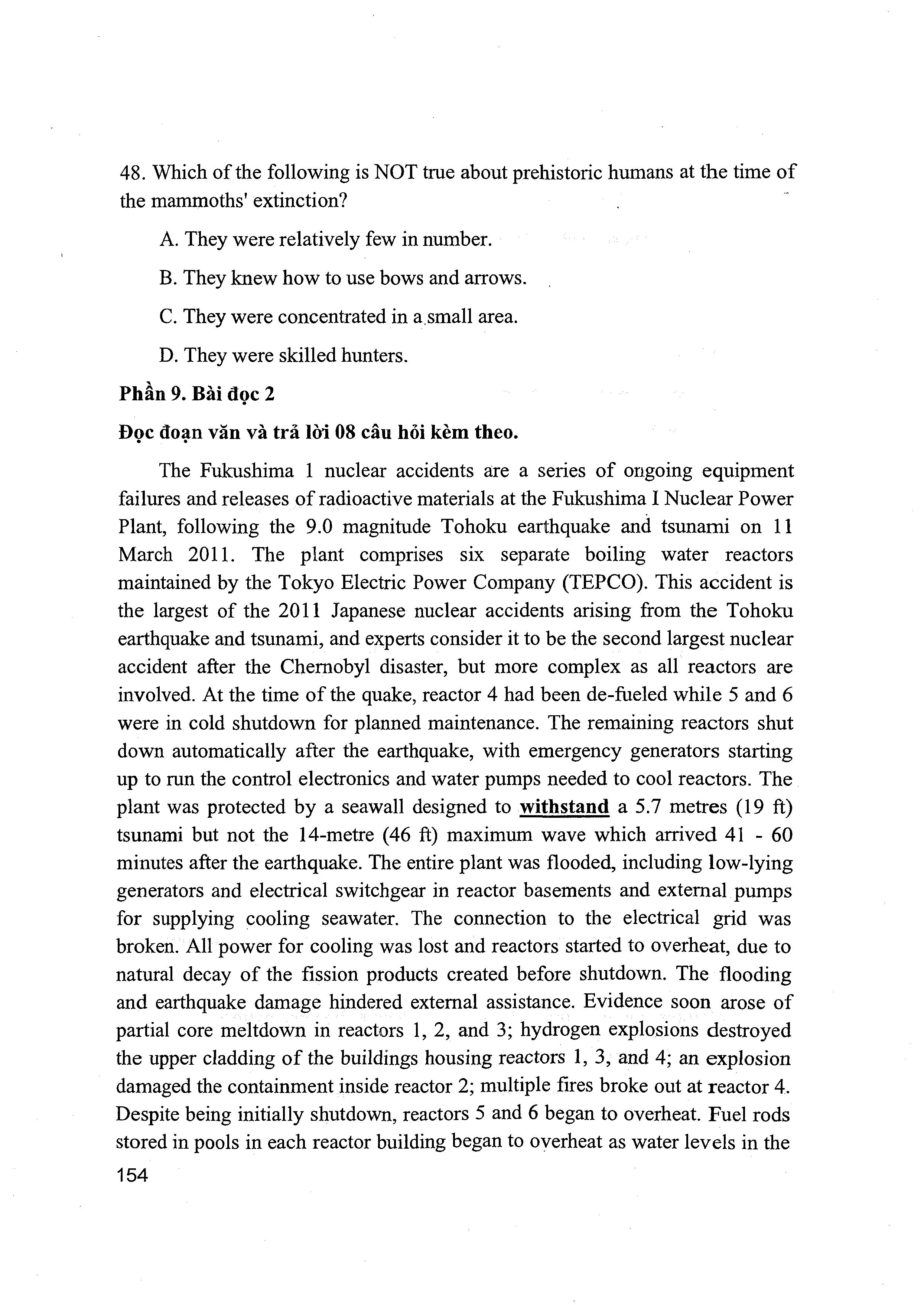
Đọc đoạn văn và trả lòi 08 câu hỏi kèm theo.
The Fukushima 1 nuclear accidents are a series o f ongoing equipment failures and releases o f radioactive materials at the Fukushima I Nuclear Power Plant, following the 9.0 magnitude Tohoku earthquake and tsunami on 11 March 2011. The plant comprises six separate boiling water reactors maintained by the Tokyo Electric Power Company (TEPCO). This accident is the largest of the 2011 Japanese nuclear accidents arising from the Tohoku earthquake and tsunami, and experts consider it to be the second largest nuclear accident after the Chernobyl disaster, but more complex as all reactors are involved. At the time o f the quake, reactor 4 had been de-fueled while 5 and 6 were in cold shutdown for planned maintenance. The remaining reactors shut down automatically after the earthquake, with emergency generators starting up to run the control electronics and water pumps needed to cool reactors. The plant was protected by a seawall designed to withstand a 5.7 metres (19 ft) tsunami but not the 14-metre (46 ft) maximum wave which arrived 4 1 - 6 0 minutes after the earthquake. The entire plant was flooded, including low-lying generators and electrical switchgear in reactor basements and external pumps for supplying cooling seawater. The connection to the electrical grid was broken. All power for cooling was lost and reactors started to overheat, due to natural decay o f the fission products created before shutdown. The flooding and earthquake damage hindered external assistance. Evidence soon arose o f partial core meltdown in reactors 1, 2, and 3; hydrogen explosions destroyed the upper cladding o f the buildings housing reactors 1, 3, and 4; an explosion damaged the containment inside reactor 2; multiple fires broke out at reactor 4. Despite being initially shutdown, reactors 5 and 6 began to overheat. Fuel rods stored in pools in each reactor building began to overheat as water levels in the
154
pools dropped. Fears o f radiation leaks led to a 20-kilometre (12 mi) radius evacuation around the plant while workers suffered radiation exposure and were temporarily evacuated at various times. One generator at unit 6 was restarted on 17 March allowing some cooling at units 5 and 6 which were least damaged. Grid power was restored to parts o f the plant on 20 March, but machinery for reactors 1 through 4, damaged by floods, fires and explosions, remained inoperable. Flooding with radioactive water through the basements of units 1-4 continues to prevent access to carry out repairs. Measurements taken by the Japanese science ministry and education ministry in areas o f northern Japan 30-50 km from the plant showed radioactive cesium levels high enough to cause concern. Food grown in the area was banned from sale. It was suggested that worldwide measurements of iodine-131 and cesium-137 indicate that the releases from Fukushima are of the same order o f magnitude as the releases of those isotopes from the Chernobyl disaster in 1986; Tokyo officials temporarily recommended that tap water should not be used to prepare food for infants. Plutonium contamination has been detected in the soil at two sites in the plant. Two workers hospitalized as a precaution on 25 March had been exposed to between 2000 and 6000 mSv o f radiation at their ankles when standing in water in unit 3. 49. What is the main topic of the passage? A. Japanese natural disaster - the nuclear power accident. B. Fukushima 1 nuclear accident - the largest nuclear power o f all time. C. The nuclear power accident - Japanese catastrophe. D. The Fukushima I Nuclear Power Plant. 50. It can be inferred from the passage th a t__________ . A. the Fukushima I Nuclear Power Plant is the world’s largest nuclear accident B. the accident happened in the early part o f the year 2011 C. Chernobyl is the world’s largest and most complex nuclear accident D. reactor doesn’t involve in the accident

155
51. The word “w ithstand” in the second paragraph is could be best replaced by
A. stand B. stand together C. wrestle D. strike 52. All o f the following are mentioned in the passage EX CEPT__________ A. the cause o f the accident is the Tohoku earthquake and tsunami B. the earthquake causes a great damage to Japan and the neighboring country C. the tsunami struck the country after the earthquake had occurred approximately an hour D. the reactor was barred from external assistance because o f the flooding and earthquake damage 53. According to the passage, which o f the followings is NOT true? A. The plant suffered à 14-metre seawall. B. The highest wave was 46 ft in height. C. The reactor 5 and 6 started overheating though they were in cold shutdown for maintenance. D. The flood with water containing radioactivity made it impossible for the machinery to be repaired. 54. According to the passage, which o f the following can be inferred? A. The Chernobyl disaster happened in the late 19th century. B. Food was banned from sale for fear that the country would run out o f food. C. The people in Tokyo were advised not to use tap water to cook for children. D. Two workers were sent to hospital as they were exposed to radiation when standing in water in unit 3. 55. When the earthquake occurred, which plants were inactive? A. 3 B. 4, 5, 6 C. 5, 6 D. 5

156
56. Why does the author mention “plutonium contam ination» in the last paragraph?
A. To show that the Japanese discovered plutonium mine after the nuclear accident.
B. To show that plutonium was contaminated after the nuclear accident c . To show that the soil was polluted by plutonium.
D. To give an example o f soil containing natural resource. Phần 10. Hoàn thành hội thoại Chọn 01 lựa chọn đúng ở mỗi câu hỏi để điền vào chỗ trống. 57. - “Did you enjoy your graduation ceremony?” - “Oh yes; I didn’t lik e__________ photographed all the time, though.” A. to have been B. having been c. being D. it to be 58. - “Did you hear anything about last month’s Barclays’ robbery?” - “Yes eventually the robbers__________ given a ten-year sentence. “ A. were B. were not being c . were not to be D. were not have been
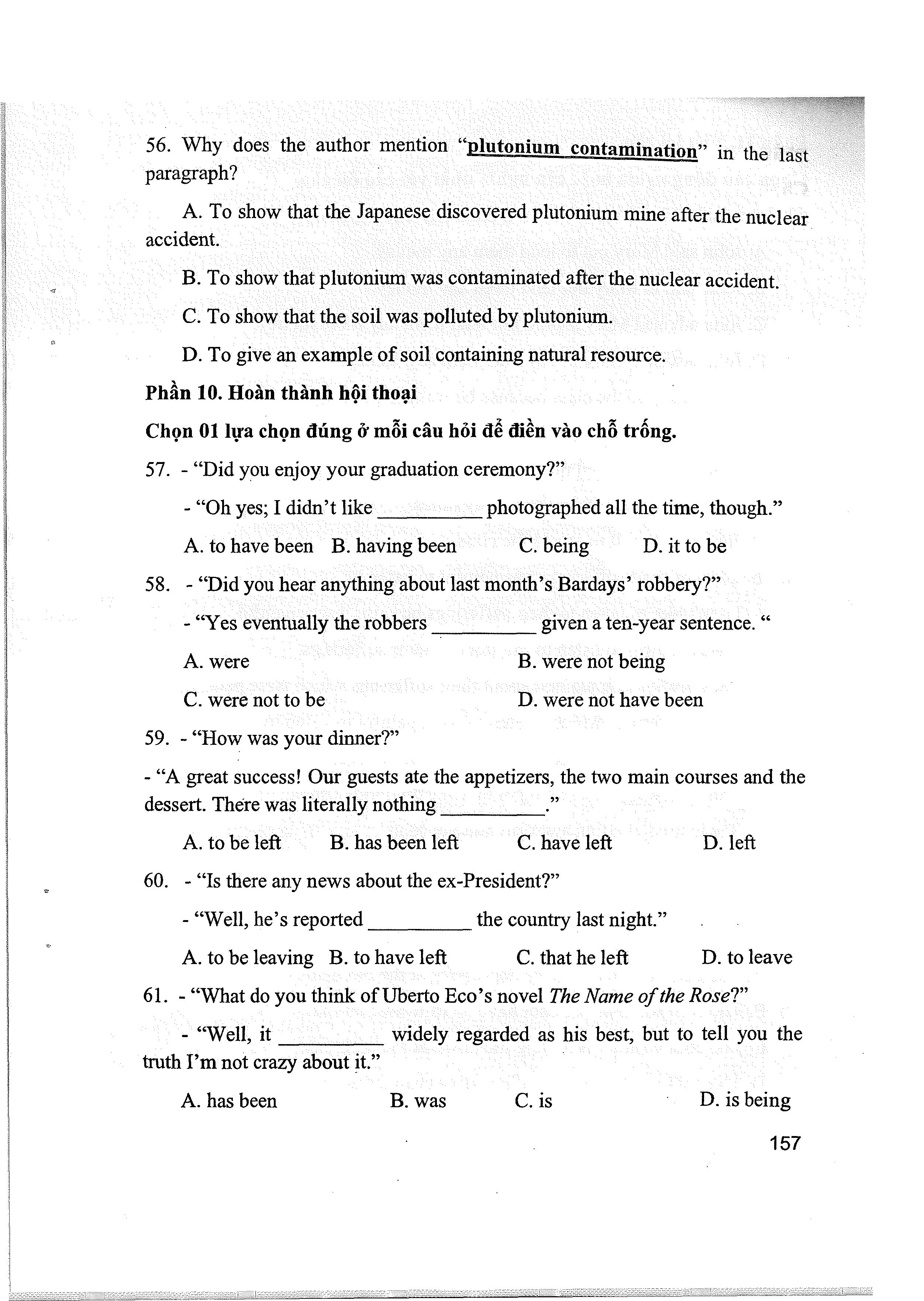
59. - “How was your dinner?” - “A great success! Our guests ate the appetizers, the two main courses and the dessert. There was literally nothing__________ A. to be left B. has been left c . have left D. left 60. - “Is there any news about the ex-President?” - “Well, he’s reported__________the country last night.” A. to be leaving B. to have left c . that he left D. to leave 61. - “What do you think of Uberto Eco’s novel The Name o f the Rose?” - “Well, i t __________ widely regarded as his best, but to tell you the truth I’m not crazy about it.” A. has been B. was c. is D. is being
157
P h ần 11. Viết lại câu
Chọn câu đồng nghĩa hoặc cận nghĩa nhất vói câu đã cho.
62. John said, "You'd better not lend them any money, Mary." A. John said Mary not to lend them any money. B. John said to Mary not lend them any money. c . John advised Mary should not lend them any more money. D. John advised Mary not to lend them any money. 63. John didn't attend the class because he was seriously ill. A. John's class was not serious. B. John never attended the class. c . John was absent from class many times. D. John was too ill to attend the class. 64. The story o f their sufferings was painful to listen to. A. I don't like to listen to their sufferings because it was painful. B. It was painful to listen to the story of their sufferings. c . They always complained about their sufferings which were painful. D. Their sufferings which I listen to were painful to listen to. 65. She's very pleased to be going away on holiday soon. A. She is looking forward to going away on holiday soon. B. She is fond at going away on holiday soon. c . She would like she went on away on holiday soon. D. She wishes she is going away on holiday soon. 66. The cold weather is really depressing me at the moment. A. The cold weather is really depressing at the moment. B. The cold weather does not have an influence on me. c . The cold weather is getting me down at the moment. D. The cold weather is sign o f negative changes now.

158
Phần 12. Kết họp câu Chọn câu đồng nghĩa hoặc cận nghĩa nhất vói cặp câu đã cho trong câu hỏi 67. “Cigarette?”, he asked. “No, thanks,” I said. A. He asked for a cigarette, and I immediately refused. B. He mentioned a cigarette, so I thanked him. c. He offered me a cigarette, but I promptly declined. D. He asked if I was smoking, and I denied at once. 68. Much of what we know about the Vikings is in the form o f centuries-old stories. Originally, the Vikings themselves told them. A. The Vikings themselves originally told centuries-old stories to US now that we know much about them. B. What we know about the Vikings is originally told to us in the form of centuries-old stories, but it is not much. c. Much o f what we know about the Vikings is in the form o f centuries- old stories originally told by the Vikings themselves.
D. Centuries-old stories were originally told by the Vikings themselves is the form o f what we know about the Vikings. 69. Many insects have no vocal apparatus in their throats. However, they make sounds.
A. Many insects make sounds so that they have no vocal apparatus in their throats.
B. The reason why many insects make sounds is that they have no vocal apparatus in their throats. c. Since many insects can make sounds, they have no vocal apparatus in their throats.
D. Many insects make sounds despite having no vocal apparatus in theừ throats.
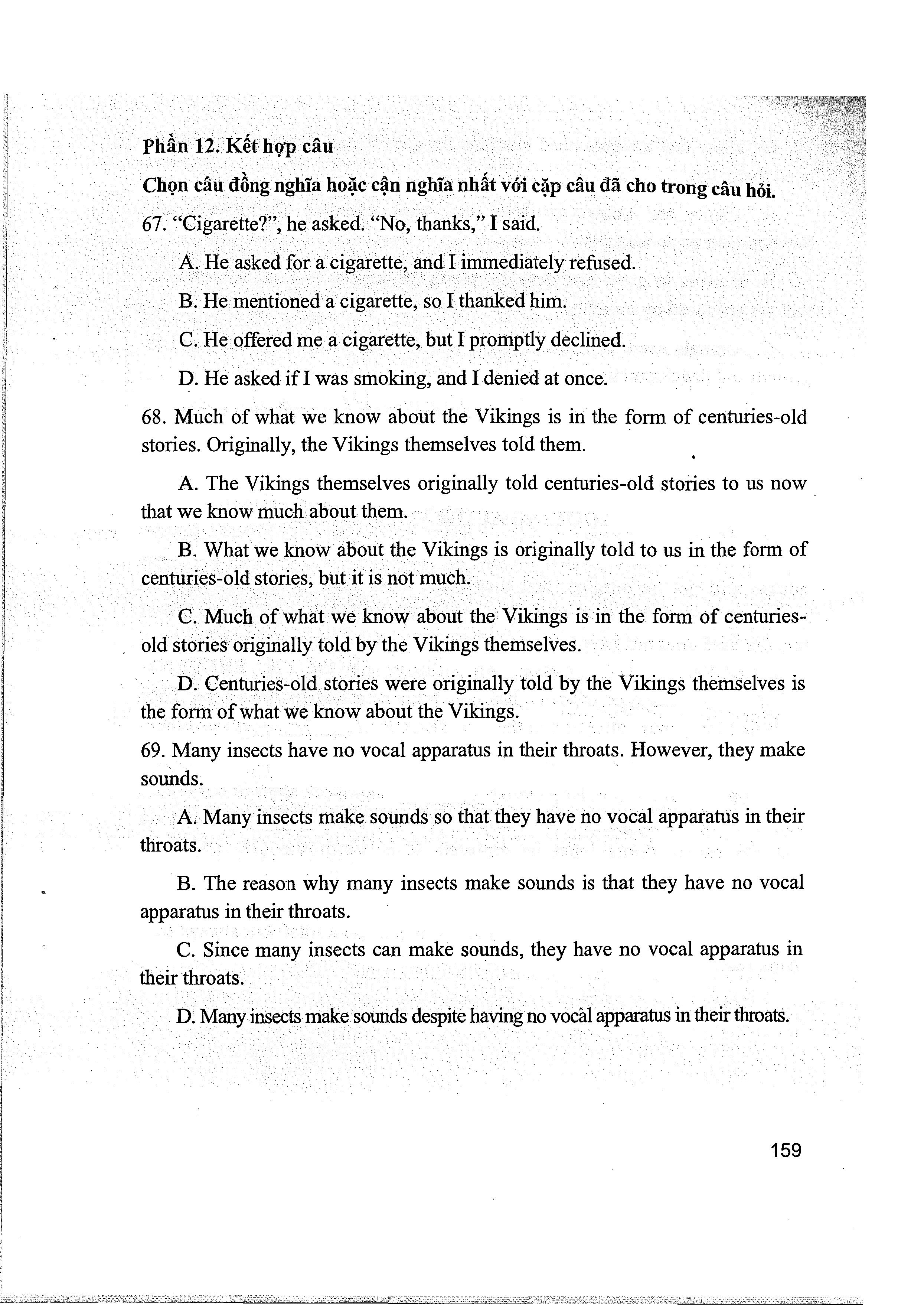
159
70. We know that animals need vitamins for growth and development. Plants need them, too. A. Plants are known to need the same vitamins for growth and development as do animals. B. In order to grow and develop, plants are known to need the vitamins that are produced by animals. c. Animals need vitamins to grow and develop whereas plants need its growth and development. D. What we know is that both animals and plants can produce vitamins for growth and development.
Phần 13. Chia dạng đúng của từ.
L O O K IN G A FT E R YOUR H O M E Residents in quiet neighborhoods are sometimes so confident that their houses will not be burgled, that they often leave their doors (71. LO CK ) _________ . Statistics show that in two (72. B U R G L A R )_________ out of ten, the thief does not have to force his way in, as the door or window has been (73. LEAVE) _________ open. An initiative for the (74. PREV EN T) _________ of this type o f crime has now been launched by the police. They want us to pay more attention to the (75. S E C U R E )_________ o f our homes and take some simple precautions. First, we should (76. S T R O N G )_________ any weak spots in our homes where a thief could get in. For example, (77. B R E A K )_________ windows and old garage doors must be replaced. It is worth the (78. INV EST) _________ o f a sum o f money, however large, as it will buy us piece o f mind. Secondly, it is (79. A D V IS E )_________ never to leave spare keys in (80. H ID E )_________ places such as flower-pots because a thief will always look there first.
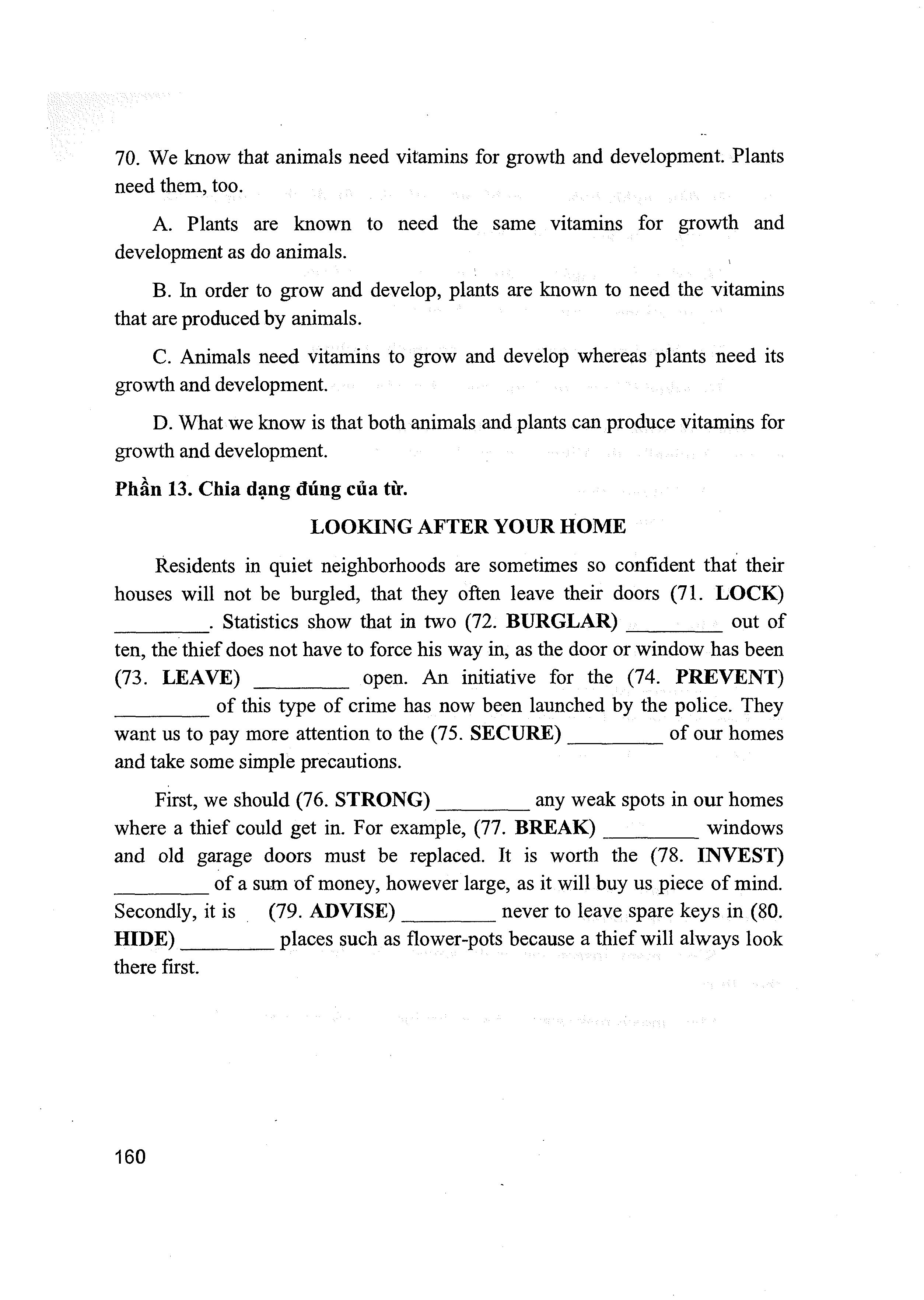
160
Phaii 14. Lựa chọn 1 từ thích họp có thể điền vào được 03 câu cho sẵn dưới đây. 81.............................. • Before any major fight the champ trains in the gym every day for 4 hours w ithout _________ .. • You are too kind to me. I don’t know what to say. Words me! • I _________to understand why he’s so nasty most o f the time. He can be nice when he wants. 82.............................. • This pastry is disgusting. I wouldn’t even recommend that you it. I think it might have gone off. • To tell you the truth, you have b a d_________ in clothes. Why don’t you read some fashion magazines? They might teach you something. • Red cars are a bit too extravagant for m y_________. I prefer blue or light green. 83.............................. • He planned to stay in the box with 1000 scorpions for three months, an act which was supposed to put all the other entertainers in th e_________ . • When the sun reached its zenith, they wanted to find some_________to escape from its scorching rays. • The artist uses a combination o f light a n d_________in his drawings to highlight certain recurring cycles in our lives. 84. ................. ......... • After a short period of severe winter, plants came to _________ again displaying their gorgeous flowers. • Moving west gave her a new lease o f_________ . The climate was better and the people were more hospitable. • Lisa’s parents were unaware that she was leading a double __________ . Actually, nobody knew she had become a drug addict.

161
85...............................
• Yes, you’re right. I shouldn’t have reacted the way I did. I _________ you a sincere apology. • Don’t forget you still m e5 pounds. You won’t get away with this. • They always feel extremely grateful for his kind help and support. In fact, they think they__________ everything to him.
Phần 15. Viết một bài luận 200 - 250 từ về chủ đề sau.
Which method o f learning do y o u prefer: Self-study or Teamwork? Use specific reasons a n d examples to support y o u r choice.
162
